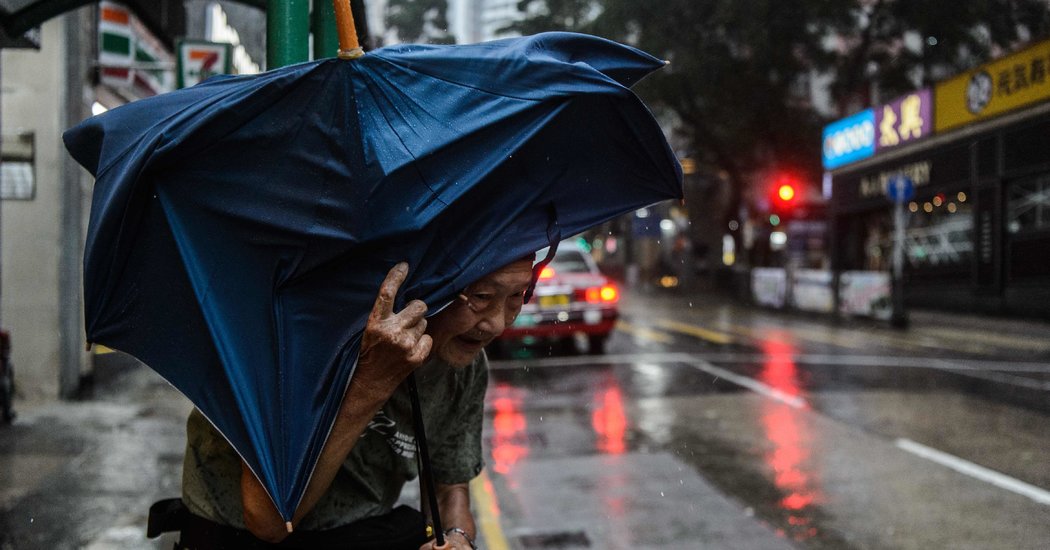Hong Kong is used to fierce storms, but when Typhoon Mangkhut struck the city on Sunday, it soon became clear that this one was different. Wind gusts as strong as 120 miles an hour swept through the city, rocking tall buildings and fueling storm swells that threatened the coastline with waves as high as 40 feet.
At midday, the city’s normally teeming streets were devoid of people and cars. The weather authority issued its highest typhoon warning, a signal 10. The government also issued a landslide warning, urging people to stay away from steep hills and retaining walls and asking residents in vulnerable areas to evacuate.
And for the first time ever, Macau, the Asian gambling capital farther along the Chinese coast, closed its casinos because of a storm.
Hong Kong residents hunkered down in their apartments, having cleared many grocery store shelves the day before in preparation.
Others took refuge in shelters. The city’s airport, a central transit point for much of Asia, was virtually shut down, with almost 900 flights canceled. The outdoor sections of Hong Kong’s vaunted subway system were taken out of service. In Mong Kok, a crane collapsed at a construction site, but no injuries were reported.
Scaffolding collapse at a building site in Kowloon pic.twitter.com/O69ILlXOJr
—
高地柏啲 (香港) (@HighlandPaddyHK)
Sept. 16, 2018
Hong Kongers took to Facebook and WhatsApp messaging groups, circulating pictures of the hurried preparations: cars and motorcycles mummified with cling wrap, indoor storefronts encased with spiderweb-like tape. One Instagram user altered an image to add Spider-Man onto the side of a Hong Kong building, where he’d pitched in by putting tape on a window.
Credit
Bobby Yip/Reuters
But as the storm bore down in full force, the postings became more ominous. In a city of towering apartment buildings, some reported they were becoming motion-sick as their homes twisted and swayed. Videos showed glass windows and doors smashing, pedestrians being blown off the ground and residents frantically scooping rain out of their balconies to prevent flooding.
China’s southern coast is struck
Credit
Mao Siqian/Xinhua, via Associated Press
In southern China, the storm made landfall around 5 p.m. near Jiangmen City, in Guangdong Province, just across the border from Hong Kong. State television reported Sunday evening that two people had been killed, and other reports said that people had been crushed by billboards or other debris in Shenzhen and Dongguan, cities along the Pearl River.
The storm crossed the southern coast with winds as high as 100 miles an hour. As night fell, the cities along China’s southern coast largely emptied as residents heeded warnings to stay indoors, having already stocked up on food and water at stores on Saturday and earlier Sunday. Guangzhou ordered all restaurants to close to keep people off the streets, and high-speed rail service was suspended in the province.
See Inside Typhoon Mangkhut in 3-D
A NASA satellite captured the intense rainfall of 2018’s strongest storm so far.
The news agency Xinhua, citing government reports, said that nearly 2.5 million people in the province had been affected in some way, with some seeking protection in more than 18,000 designated shelters. Fishing boats had been ordered before the storm into anchorages, and the authorities detained several fishermen who had defied the warnings.
In Qiantangshan, a coastal village south of the storm’s center, residents seemed unfazed, even though officials said it was the biggest typhoon in years. “It’s not that big,” a woman selling fruit as the first wind and rain arrived had said on Sunday, vowing to stay through the day.
Guangdong, China’s most populous province, has extensive experience with typhoons, and with makes elaborate preparations for each of them. After 16 workers were killed when their shanty collapsed in a typhoon in 2003, the province pursued a strenuous campaign of demolishing or upgrading substandard housing.
The broader Pearl River Delta area, which also includes Hong Kong, is one of the world’s most important manufacturing hubs and home to more than 60 million people.
The sprawling delta is barely above sea level and has struggled with flooding despite years of investment in drainage systems. Climate change has exacerbated the problem. The provincial capital, Guangzhou, has more to lose from rising seas and more severe storms than any other city on the planet, according to a World Bank report.
Protecting China’s nuclear plants
The arrival of Typhoon Mangkhut in southern China has raised concerns about the nuclear plants that supply electricity to local manufacturers. But the area is battered by typhoons almost every year, and the Chinese government has stringent standards requiring that all critical infrastructure be able to withstand severe weather.
Workers have been taking precautionary measures at two nuclear plants along the coastline, Taishan and Yangjiang. The first reactor of the Taishan complex went online this past summer, so Typhoon Mangkhut will be its first major storm. The plant’s managers said they had held detailed planning meetings and a thorough safety inspection in the days before the storm.
“All emergency duty personnel of Taishan Nuclear Power have been on the job, all preparations have been implemented, and the Taishan Nuclear Power Base is ready,” they said in a statement on WeChat, a Chinese internet service.
The management of the Yangjiang power plant, which is right on the coast, said in a separate statement on WeChat that it had been designed to withstand large storm surges. Outdoor equipment was tied down or removed to make the site more windproof, and the reactor buildings themselves, which have reinforced concrete shells, are extremely rigid, the company said.









